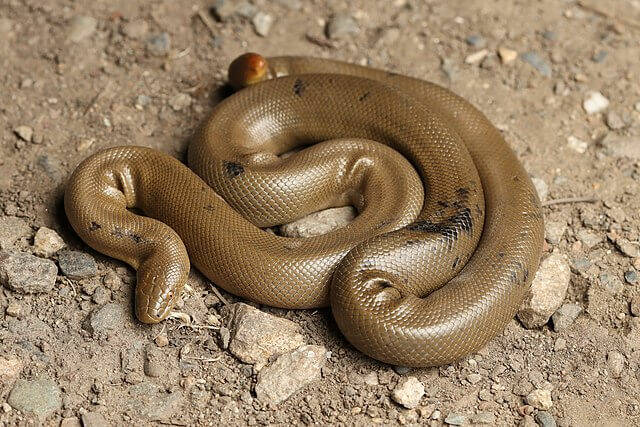By Russel Barsh
Director of Kwiaht
Somewhere on San Juan Island, resting beneath a log as it digests a vole or deer mouse, is a distant relative of the giant anacondas of the Amazon. Kwiaht scientists are asking islanders to help find and document this regionally rare and elusive non-venomous reptile.
The Northern Rubber Boa is one of only two boa species found in North America. It is also the most cold-tolerant and northerly-ranging of all boas, and the smallest, at a maximum length of barely three feet. When disturbed, it rolls up into a knot; hence the scientific name of its genus, Charina, which means “charming” or “graceful”. Colors are typically pale gray to brown or olive.
Like their much larger South American cousins, Rubber Boas are constrictors. They are known to eat mice, shrews, voles, smaller reptiles, and ground nesting birds and eggs. Also, like most other boas, Rubber Boas are viviparous, giving live birth to an average of four, fully developed young snakes. Mark Leppin has recently shown that Rubber Boas can live for a half-century; however, they appear to reproduce only once every few years.
Northern Rubber Boas have been found as far east as Montana and Utah, south to California, and north into the Fraser River Valley and the Okanagan. Although widespread geographically, these snakes are restricted to scattered, widely-separated enclaves. Like the scarce, elusive, and even smaller Sharp-tailed Snake, furthermore, Rubber Boas are shy and largely nocturnal, making it easy to overlook them.
Rubber Boas are frequently encountered in the vicinity of Wenatchee, Chelan and Spokane in eastern Washington. On the west side of the Cascade Mountains, Rubber Boas were collected in Bellingham, Camano Island, the Olympic Mountains near Port Angeles, and lower mainland of British Columbia in 1930s-1950s. Recent sightings have mainly been in the south Sound, but there have also been iNaturalist reports of Rubber Boas at Bow, Chuckanut, and Bellingham.
There have been sporadic verbal reports of Rubber Boas in the San Juan Islands for decades but neither photographs nor specimens to verify them. Like Sharp-tailed Snakes, which Kwiaht now studies on Mount Young and the Turtleback, Rubber Boas may yield to systemic searches, using “artificial cover objects” and bait to attract them.
Rubber Boa populations on mainland western Washington appear to be shrinking, and may be threatened here in the islands as well. Predators of Rubber Boas include racoons, raptors such as Red-tailed hawks, and cats. We have already seen evidence that residential growth on Cady Mountain, together with its increase in outdoor cats, has had an adverse impact on Northern Flying Squirrels. Residential expansion may also be affecting Rubber Boas.
Together with their patchy geographic distribution, Rubber Boas’ long lifetimes and low fertility make them especially vulnerable. Disturbance of a small habitat area, such as the 20 acres åor so that seem to that comprise the territory of Sharp-tailed Snakes on Mount Young, can impact an entire regional population of snakes, and at best it would take them decades to recover.
Kwiaht director Russel Barsh and herpetologist Christian Oldham will be at the San Juan Island Community Foundation booth at the County Fair on Saturday afternoon August 17, beginning at 3:00 pm, to answer questions about the Rubber Boa and other native island reptiles; and to raise funds to strengthen their efforts on behalf of the Rubber Boa, Sharp-tailed Snake, Alligator Lizard and even more mysterious and elusive Western Pond Turtle!



